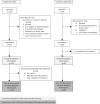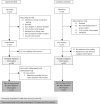Medical radiation exposure and risk of retinoblastoma resulting from new germline RB1 mutation
- PMID: 20648557
- PMCID: PMC3124307
- DOI: 10.1002/ijc.25565
Medical radiation exposure and risk of retinoblastoma resulting from new germline RB1 mutation
Abstract
Although ionizing radiation induces germline mutations in animals, human studies of radiation-exposed populations have not detected an effect. We conducted a case-control study of sporadic bilateral retinoblastoma, which results from a new germline RB1 mutation, to investigate gonadal radiation exposure of parents from medical sources before their child's conception. Parents of 206 cases from nine North American institutions and 269 controls participated; fathers of 184 cases and 223 friend and relative controls and mothers of 204 cases and 260 controls provided information in telephone interviews on their medical radiation exposure. Cases provided DNA for RB1 mutation testing. Of common procedures, lower gastrointestinal (GI) series conferred the highest estimated dose to testes and ovaries. Paternal history of lower GI series was associated with increased risk of retinoblastoma in the child [matched odds ratio (OR) = 3.6, 95% confidence interval (CI) = 1.2-11.2, two-sided p = 0.02], as was estimated total testicular dose from all procedures combined (OR for highest dose=3.9, 95% CI = 1.2-14.4, p = 0.02). Maternal history of lower GI series was also associated with increased risk (OR = 7.6, 95% CI = 2.8-20.7, p < 0.001) as was the estimated total dose (OR for highest dose = 3.0, 95% CI = 1.4-7.0, p = 0.005). The RB1 mutation spectrum in cases of exposed parents did not differ from that of other cases. Some animal and human data support our findings of an association of gonadal radiation exposure in men and women with new germline RB1 mutation detectable in their children, although bias, confounding, and/or chance may also explain the results.
Copyright © 2010 UICC.
Figures
Similar articles
-
Parental nutrient intake and risk of retinoblastoma resulting from new germline RB1 mutation.Cancer Causes Control. 2013 Feb;24(2):343-55. doi: 10.1007/s10552-012-0120-x. Epub 2012 Dec 8. Cancer Causes Control. 2013. PMID: 23224327 Free PMC article.
-
Parental diet and risk of retinoblastoma resulting from new germline RB1 mutation.Environ Mol Mutagen. 2012 Jul;53(6):451-61. doi: 10.1002/em.21705. Epub 2012 Jun 25. Environ Mol Mutagen. 2012. PMID: 22730229
-
Medical radiation exposure and risk of sporadic retinoblastoma.Pediatr Blood Cancer. 2020 Nov;67(11):e28633. doi: 10.1002/pbc.28633. Epub 2020 Aug 2. Pediatr Blood Cancer. 2020. PMID: 32743912
-
RB1 gene mutations in retinoblastoma.Hum Mutat. 1999;14(4):283-8. doi: 10.1002/(SICI)1098-1004(199910)14:4<283::AID-HUMU2>3.0.CO;2-J. Hum Mutat. 1999. PMID: 10502774 Review.
-
Genetics of Retinoblastoma.Asia Pac J Ophthalmol (Phila). 2016 Jul-Aug;5(4):260-4. doi: 10.1097/APO.0000000000000219. Asia Pac J Ophthalmol (Phila). 2016. PMID: 27488068 Review.
Cited by
-
Perinatal characteristics and retinoblastoma.Cancer Causes Control. 2012 Sep;23(9):1567-75. doi: 10.1007/s10552-012-0034-7. Epub 2012 Jul 29. Cancer Causes Control. 2012. PMID: 22843021 Free PMC article.
-
Parental nutrient intake and risk of retinoblastoma resulting from new germline RB1 mutation.Cancer Causes Control. 2013 Feb;24(2):343-55. doi: 10.1007/s10552-012-0120-x. Epub 2012 Dec 8. Cancer Causes Control. 2013. PMID: 23224327 Free PMC article.
-
A Critical Review of the Removal of Radionuclides from Wastewater Employing Activated Carbon as an Adsorbent.Materials (Basel). 2022 Dec 9;15(24):8818. doi: 10.3390/ma15248818. Materials (Basel). 2022. PMID: 36556624 Free PMC article. Review.
-
A case-control study of paternal occupational exposures and the risk of childhood sporadic bilateral retinoblastoma.Occup Environ Med. 2013 Jun;70(6):372-9. doi: 10.1136/oemed-2012-101062. Epub 2013 Mar 16. Occup Environ Med. 2013. PMID: 23503471 Free PMC article.
-
Mutation risk associated with paternal and maternal age in a cohort of retinoblastoma survivors.Hum Genet. 2012 Jul;131(7):1115-22. doi: 10.1007/s00439-011-1126-2. Epub 2011 Dec 28. Hum Genet. 2012. PMID: 22203219 Free PMC article.
References
-
- Russell LB. Role of mouse germ-cell mutagenesis in understanding genetic risk and in generating mutations that are prime tools for studies in modern biology. Environ Mol Mutagen. 1994;23:S24, 23–9. - PubMed
-
- Board on Radiation Effects Research, National Research Council, editor. Heritable genetic effects of radiation in human populations Health risks from exposure to low levels of ionizing radiation: BEIR VII Phase 2, Committee to Assess Health Risks from Exposure to Low Levels of Ionizing Radiation. The National Academies Press; Washington, DC: 2006. pp. 91–131.
-
- Bouffler SD, Bridges BA, Cooper DN, Dubrova Y, McMillan TJ, Thacker J, Wright EG, Waters R. Assessing radiation-associated mutational risk to the germline: repetitive DNA sequences as mutational targets and biomarkers. Radiat Res. 2006;165:249–68. - PubMed
-
- Wyrobek AJ, Mulvihill JJ, Wassom JS, Malling HV, Shelby MD, Lewis SE, Witt KL, Preston RJ, Perreault SD, Allen JW, Demarini DM, Woychik RP, et al. Assessing human germ-cell mutagenesis in the Postgenome Era: a celebration of the legacy of William Lawson (Bill) Russell. Environ Mol Mutagen. 2007;48:71–95. - PMC - PubMed
-
- Bunin GR, Meadows AT, Emanuel BS, Buckley JD, Woods WG, Hammond GD. Pre- and post-conception factors associated with heritable and non-heritable retinoblastoma. Cancer Res. 1989;49:5730–5. - PubMed
MeSH terms
Grants and funding
LinkOut - more resources
Full Text Sources
Miscellaneous



